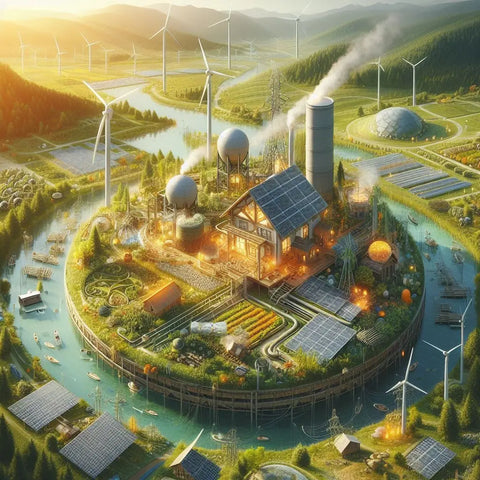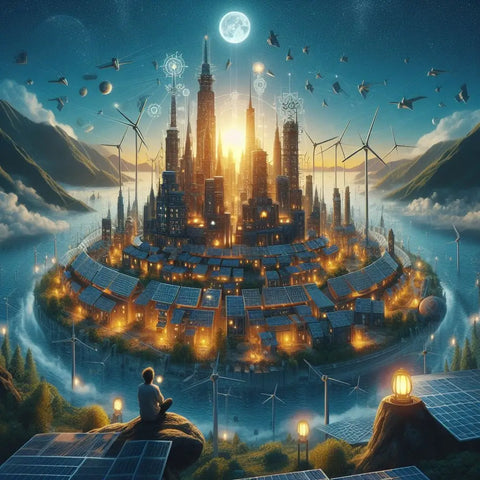The Role of Renewable Energy in Regenerative Design
Implementing Renewable Energy Systems in Permaculture Projects
Renewable Energy
The regenerative design method, which, namely, represents the systematic approach to transforming human habitats and farmlands into sustainable ones, has over the years placed renewable energy at the center stage. With the integration of renewable sources of energy into permaculture designs, the designers can come up with networks that are closed, which will largely reduce the dependence on fossil fuels while further ensuring efficient use of locally available, renewable resources. Implementing renewable energy systems in permaculture projects is the main component for developing nature-created communities with high endurance and self-dependency.

Renewable Energy and Permaculture
The most basic concept in permaculture is the principle of relying on nature to act as the model. This includes proposing ways that will ensure that human settlements mirror ecosystems. Natural ecosystems are characterized by the movements of the energy within which the motion of energy goes in circles and the waste from one process becomes the input for another. The aim is to create natural systems like these with a loop where nothing is wasted. Therefore, the implementation of renewable energy systems in permaculture projects is needed to reach this end.
Permaculture designs are always attempting to embrace renewable energy sources such as solar, wind, hydro, and geothermal to better eliminate the traditional, fossil-fuel-based energy sources. It not only cuts down their environmental footprints but also makes them more sustainable, responsive, and self-reliant, which are key ingredients of sustainable agri-tech. It is the case that if a permaculture project is fully energy self-sufficient by producing its renewable energy, it will become better and more independent from power breakdowns, price swings, and other imbalances in the current centralized energy system.
Last but not least, renewable energy systems also can effectively fit into permaculture system design in a way that engenders symbiotic relationships. Likewise, panels can be located on top of stable greenhouses to simultaneously supply electric power and shading to maximize growing conditions. Wind turbines positioned in the slanted side landscaping by the permaculture design offer an advantage that allows for the exploitation of such microclimates. Having the renewable energy systems and the food production systems in permaculture projects combined and placed in such a manner will allow the energy systems to promote each other.
Renewable Energy Technologies for Continuous Cultivation
Besides being a dominant component of renewable energy that is mostly employed in permaculture, solar power can be scaled to accommodate any size of the system, be reliable, and replicate without difficulty. The photovoltaic solar cells can be located on the roofing structures, placed on the ground as arrays, or used in other permaculture elements such as greenhouses or animal shelters. Solar power is a changeable and multipurpose alternative that can provide energy for numerous electrical applications, such as street lighting, water pumping, and other devices.
Helpful winter products include wind power, yet climate-changing technologies are most suitable for energy projects in habitats with continuous and moderate wind speeds. Whether the wind farms are small or large and sited to fit into the microclimate of the agroclimatic vegetation, the turbines can generate a lot of power. It is beneficial to use wind power and solar power together because they are mostly peaking whenever the wind is not blowing and when the sun is not shining.
Like hydropower, which utilizes flowing or descending water in an ecologically sound manner to generate energy, hydropower can also be used in renewable energy systems in agriculture projects, especially on large farms. For example, micro-hydroelectric generators, like those that are harnessed in streams or rivers, can generate continuous and predictable outputs. For the water management systems involving permaculture designers, hydropower is integrated and roped so that the same infrastructure can be used to produce energy as well as irrigate.
Another renewable source perfect for permaculture is geothermal energy. It involves using hot water or steam from within the earth. Shallow pumping of the groundwater can be used for both heat production and cooling in the buildings. Depending on the depth of the geothermal wells, a continuous supply of renewable energy to the grid can also be efficiently generated. Geothermal plants operate in a base-load mode rather than the non-renewable intermittent nature of wind and solar-powered systems.
Effects of Renewable Energy Systems on Permaculture Projects
When designing renewable energy systems for agroforestry operations, it is a whole system approach that would include the energy system in the bigger permaculture plan. The thing is to precisely gauge the resource base as well as the energy demand and, most especially, identify and harness the possibilities of energy production readily available and workable within permaculture.
The initial step is to conduct a comprehensive site analysis, indicating the landscape, exact microclimate (temperature, precipitation, etc.), and infrastructure that are needed to use renewable energy potential. Such figures will accordingly help to construct scenarios with various renewable energy forms and choose the most appropriate technological mix for the project.
The renewable energy system will be designed at some point, and later it will be matched to the permaculture system without any overlap. To illustrate this permits for installation on structures such as greenhouses or animal shelters that have existing structures can be given, as such structures can function as an advantage. Wind turbines can be positioned to harmonize their presence with the windbreaks and the shelterbelts of the permaculture. Hydropower plants can be located near irrigation structures or fish ponds, where they can provide additional energy for these systems. With renewable energy systems designed right into permaculture projects, the system becomes part of the overall design, making renewable energy a productive and integral aspect of the design.
Besides the conventional issue of energy storage and distribution, renewable energy system installation is another thing to be considered when running a permaculture project. More than often, renewable energy tends to be a variable source, meaning that if the storage, like batteries or thermal storage, is not effective enough, the adequate supply may be compromised. Furthermore, the permaculture project that will be practiced may require microgrids or other decentralized methods of distribution to satisfy the energy responsibilities of the site varieties.
In the last point, when implanting renewable energy systems in permaculture projects, attention should also be paid to resilience and adaptability. Technologies that allow for easy repair and that can sustain the varying conditions of the site are desirable technical components in permaculture designs. The renewable power module would be conciliated enough to adjust to future transformations of the permaculture project, like the addition or reduction of land or alternation in land use.
Lessons from the Renewables Workshop and Practical Applications for Permaculture
So, there are many examples given around the globe that follow the route of embracing renewable energy sources in permaculture projects to show that it is feasible. The Hundred Acres of Permaculture System in Australia is just one of the examples that has an all-inclusive renewable energy system as part of its design.
A hundred Acres of permaculture designers had a solar array installed to generate the electric power for the whole project, plus the wind turbine of a smaller size was used as an additional source. The panels are installed on stone structures by using a combination of hydrogen fuel cells and other renewable energy sources such as winds and tides. The greenhouse, chicken coops, and permaculture elements are also built on these structures, bringing nutrient cycling, beneficial pollination, and other roles into the energy system. This project harnesses solar energy through passive design, geothermal heating and cooling, and a grid system to enable energy distribution.
Another example takes place at the Permaculture Research Institute in New Zealand, which designed Over the years, they have advanced projects through the implementation of renewable energy systems like solar, wind, and micro-hydro power. An integrated renewable energy system is an institutional entity's power supply through which its buildings, greenhouses, and other infrastructure can be powered. This integrated renewable energy system is also a great demonstration site for other people.

Demonstrating how the integration of renewable energy systems into permaculture projects does rather brings close to a community that is not only robust but also truly self-sufficient and works in natural harmony with the environment. A general systems approach coupled with a fit-in with the overarching permaculture design will prove particularly helpful to take advantage of those synergies that otherwise might not be considered.
Conclusion
Integrating permaculture with renewable energy systems is the next big step in forming settlements that are sustainable and resilient and meet human needs. Implementing a green energy provision from solar, wind, hydro, and geothermal power as a part of permaculture does the right job in this case by reducing fossil fuel use to the minimum or totally.
FAQs
Why would you use renewable energy in your permaculture settings?
Implementing renewable energy systems in permaculture projects should be greatly cared for because these endeavors will, by their very nature, design a closed-loop, self-sufficient system that should minimize the reliance on popular fossil fuels and the power grid. It serves two purposes: being self-sufficient and operating by natural systems, where the permaculture projects do not depend on the centralized grid and are in harmony with nature.
What are the main renewable energy technologies implemented in permaculture domains?
The permaculture design projects deployed the diversified renewable energy technologies of solar power, wind power, hydropower, and geothermal energy systems. One can only find in these systems of technology the elements that are used in harmonious camaraderie to achieve better yields and the creation of the best output.





Leave a comment